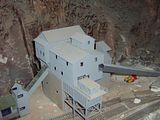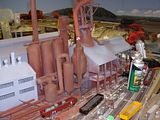Hello All!
I am looking into building an ore mine module for the layout at my club. I was wondering if anyone could point me towards any good information on the subject of prototype ore mines and/or modeling a ore mine in general. The module I am working with is around 5x8…HO scale. The layout is freelance so we don’t have a specific time period, except to say it will fall under the diesel era. Any help will be greatly appreciated.
Thanks!
The internet could be one of your best friends for finding information. You will have to do some research if you want to replicate a prototype. Here’s an article about replicating a prototype layout. It’s about general layouts, and not industry specific, but some the general tips can be helpful. You may also be able to find books about the ore mining industry and find pictures of their track layout. If you know of any modern ore mines, and where they are located, you can try Google maps and use the satellite view to get a birds-eye view of the tracks.
Hi SAL 1911 and [#welcome] to the forum.
The type of ore which you’re mining will have quite an influence on what the site will look like. In most places, iron ore, copper, nickel, and aluminum mines are simply large holes in the ground - very large holes. The ore is generally moved by the trainload. Gold and silver mines are often shaft-type mines, with a hoist house marking the mine’s opening. Processing structures are usually nearby, but the amount of material shipped may be only a car or two at a time.
Your first step should be to determine the type of ore you wish to mine, then let google overwhelm you with information. [swg]
Wayne
Here are some pictures from my last worksite down in Australia.
This Flood loader services 400+ hoppers per day.

And these are the horses that pull the dirt to port…

I concur with Dr.Wayne - if you want it to look “right” or “real”, you had best decide just WHAT kind of ore that you are loading, and then do the research on that type of mining. In modeling, we might go about that backwards… For example, if you want a place to load those shorty iron ore cars, then you will want to create an iron ore mine, which is usually open pit. Is the ore to be hauled by open hoppers, covered hoppers, or by the bag-full in box cars or on flats (as was done with early gold and silver mining in places like Colorado)?
Chat with the other club members about what kind of ore they would like to see.
Bill
Yup, really depends on what type of “ore” you’re talking about. There’s iron ore, gold ore, silver ore etc. There’s a big difference between the operation of an open pit iron mine on the Mesabi Range in Minnesota, compared to a narrow-gauge railroad’s gold ore operation in the mountains of Colorado.
Some good suggestions to help narrow down things. My take?
Location, location, location.
Ores are distributed across Earth’s geology very unevenly. Usually, the type of ore mined is found in specific locations were it is economically recoverable. You generally don’t have iron mines in Florida and Minnesota and Michigan don’t have phosphate mines. Determining place will help narrow down the options.
In general, base metal ores (Iron, copper…) are mined in open pits and move some distance to the refining facility. Precious metals are usually mined in underground mines and are usually semi-refined (concentrated) at the head of the shaft.
Diesel-era copper mines are truck-hauls, and are HUGE - as in full-scale swimming pool size. Even when the product is concentrated on-site (seen near Tucson, AZ) the concentrated ore leaves in trainload lots for the electrolytic refining facility a long rail haul away. (Incidentally, that electrolytic refinery produces gold and silver as by-products, but those products leave THAT refinery in armored trucks, not railcars.)
To get an idea of what modern facilities are like, Google iron mines or copper mines. Both will link to specific companies and operations. Satellite views are available for most, and will provide insight into the structures, their layout and their relationship to haul roads and rail connections.
Chuck (Modeling Central Japan in September, 1964 - mining coal, not ore)
As all have said…
It does depend on the era and type of ore.
For example. A modern Iron ore mine is made up of 4 or more areas depending on the size of the mine.
-
The Ore pit is where the ore is dug up out of the ground.
-
The Primary crusher, this is where the ore is dumped by Haul Pak (a tip truck that carries in excess of 400 tonnes on its wheels) and ground down to a manageable size for processing.
-
The coarse ore stockpiles or “COS” . This is where the primarily crushed ore is stored in waiting for further processing.
-
The Tertiary crusher. This is where ore from the COS is crushed down further to be delivered by conveyer to be cleaned and separated.
-
The product screens and de-sanding area. This is where ore and other products are separated by gravity fed tumblers and screening machines to deliver pure ore by conveyer to the stockpiles.
-
The stock pile is usually made up of 2 or more rows of ore which is piled in lines by a loader/reclaimer unit which can pick at any time to load outgoing train when they arrive.
-
The Flood loader feed the hopper cars with ore to be transported to port or other manufacturing industries.
Some of our conveyer systems in Western Australia carry ore up to 10 km from the pit.
[8-|]
I have to assume that your layout is HO and that you have adequate area to spread out the mine complex and related industries that are railroad intensive. Walthers has kits for many of the related structures. I happen to have a 24’x24’ around the room HO layout two harbors, an open pit iron ore mine and crusher, a coke-gas retort, a limestone open pit mine and crusher, blast furnace with blower, and a roller mill, plus two ore carriers. two Hulett unloaders and an 18 bin loader, plus storage buildings, and storage tracks. The idea is to choose a mine that is related to other structures, and is railroad intensive. Bob Hahn 




